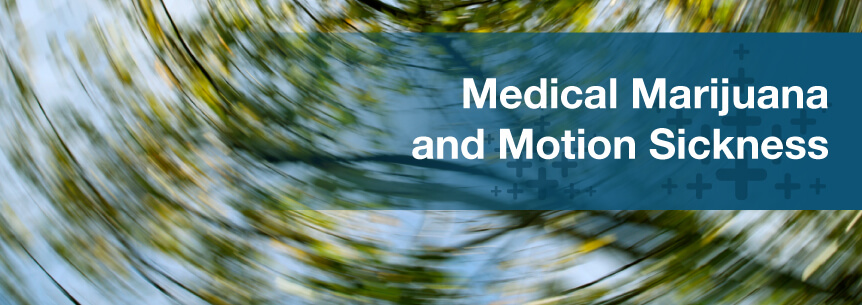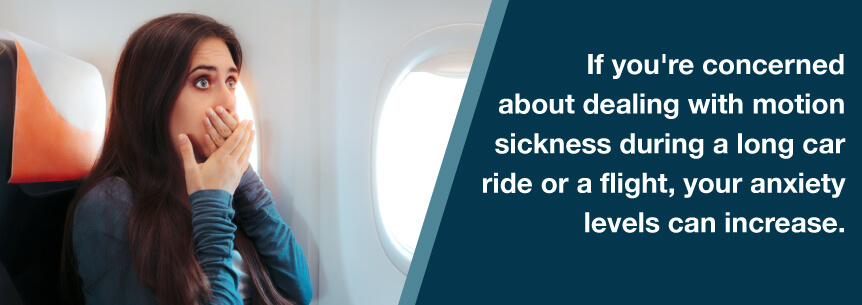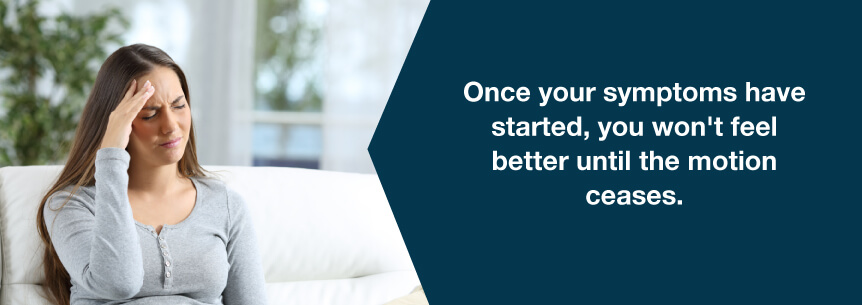
Everybody has experienced nausea and vomiting at some point in their life. And, as you’re probably aware, motion sickness can cause nausea. The good news, cannabis for motion sickness is available in many states, and the herb has the power to treat nausea. It also can work wonders on combating the other symptoms of motion sickness.
Advocates suggest trying medical marijuana for easing chemotherapy-induced nausea, but research shows it can also help with motion-induced nausea.
There are various compounds and cannabinoids in cannabis. The one cannabinoid that can potentially combat motion sickness and other symptoms related to it is CBD. Research suggests CBD treatment activates certain somatodendritic 5-HT (1A) receptors reducing the release of the chemical that triggers nausea.
A German research team conducted a study in 2010 wherein they analyzed blood samples they took from human volunteers before parabolic flight maneuvers, as well as during and after. Parabolic flight is the simulation of space travel’s weightlessness. Pilots nose-dive the airplane for around 30 seconds and then pull out sharply for another 30 seconds at an approximate two G-forces toll before they weightlessly careen downward again.
Researchers found the volunteers who became sick had lower endocannabinoid levels, whereas those who didn’t get sick experienced a rise in their endocannabinoid levels.
Find A Doctor Find A Dispensary
Treatments for motion sickness include ginger, anti-emetics and dimenhydrinate. Medications used for motion sickness have a risk of abuse and overdose. With dimenhydrinate, this can include seizures and loss of consciousness.
Medical marijuana has been shown to help some with motion sickness. Like other medications, there is a risk of overuse. However, medical marijuana has been proven utterly safe concerning overdose and emergency side effects. In other words, there has never been a single documented case of marijuana overdose resulting in a medical crisis. You cannot overdose on marijuana, though you should adhere to prescribed doses of medical marijuana.
Symptoms medical marijuana for motion sickness can treat include:
The primary symptom of motion sickness is nausea. Doctors often treat patients with nausea with drugs called anti-emetics. According to the National Cancer Institute, there is not enough information to definitively declare inhaled cannabis is a viable treatment option for nausea. However, the National Cancer Institute also states cannabinoid medications are FDA-approved for nausea and vomiting. They not only work on nausea and vomiting, but they often work better than the currently available non-cannabinoid treatments.

There are currently two cannabinoid medications available for nausea and vomiting in the United States. These drugs are Delta-9-THC medications, going by the names nabilone and dronabinol. The active ingredient — tetrahydrocannabinol — in these medications is the same as found in the marijuana plant.
Therefore, further testing of inhaled marijuana regarding nausea and vomiting seem likely to produce similar results. At this time, the drugs are approved to treat cancer patients undergoing chemotherapy. The FDA has not cleared these medications for use with motion sickness. However, this does not mean they do not show promise for all types of nausea and vomiting.
What makes medical marijuana and motion sickness treatment so effective and intriguing is how it inhibits nausea and vomiting at a psychological and cellular level. For some individuals, their anxiety, linked with susceptibility to motion sickness can evoke symptoms. Even in more serious cases where medical weed can’t eliminate nausea, the herb’s psychological effects can help decrease motion-sickness-induced anxiety.
Some good marijuana and motion sickness strains are those that can tackle the uncomfortable symptoms of motion sickness like nausea, pain, stress, anxiety and the others mentioned above. These strains include the following.
There are a variety of delivery methods for you to get your cannabis and motion sickness treatment. Each method of administration produces a different effect and has different medicinal qualities. By experimenting with a few strains, you’ll be able to find the ones to work best for you. Some good choices include:
You can always smoke your cannabis for motion sickness treatment, too, but marijuana doctors would likely frown on this, since there are questions about its ability to harm your lungs.
Once you’ve researched medical cannabis for motion sickness, you’ll want to find a cannabis-friendly doctor next who will provide you with your recommendation for medical pot. You’ll be building an ongoing relationship with this doctor, so be sure you choose a medical professional you feel comfortable with.
Before buying your marijuana for motion sickness, read up on your state’s laws regarding medical cannabis. Each state has different laws, and you want to abide by them. Once you have chosen your cannabis doctor and they provide you with your recommendation, you can search our large database of marijuana dispensaries so you can start shopping for your customized medical cannabis treatment plan.
Find A Doctor Find A Dispensary
If you’ve ever had motion sickness, you know how uncomfortable motion sickness can be if you’ve been sick to your stomach in a car, airplane or boat. While motion sickness doesn’t lead to any long-term issues, if you travel often, it can be miserable.
Motion sickness also goes by the names of carsickness, airsickness or seasickness. And, although anyone can experience motion sickness when there’s enough motion, there are still many questions as to why some people are more prone to getting sick in cars, planes, boats and other things causing motion.
Even though children and pregnant women have a higher risk of getting motion sickness, just about anyone who travels has a risk as well. For individuals traveling on boats, seasickness is also a type of motion sickness. Other risk factors are:

According to the prevailing theory of the causes of headaches, nausea and dizziness associated with motion sickness, traveling in vehicles causes confusion among individuals’ senses. Typically, you use your ears, eyes and feet to keep your balance while you’re maneuvering around the world.
Your inner ear is the center of your vestibular system, which deals with balance and movement. If your eyes are telling you one thing — such as you’re sitting in a vehicle — and your ears are telling you another thing — like you’re driving down the road at 80 miles per hour — there is a mismatch that can cause an issue.
Another example is when you’re at the movies and onscreen there’s a rollercoaster going down a steep track. Your eyes communicate you’re going down this steep track, while the seat of your pants communicates you’re staying put. This is another scenario of a mismatch where individuals who are looking at screens get motion sickness.
Strong smells, from gasoline or food, can also trigger motion sickness. You may trigger motion sickness by traveling in a car and reading a map or book. Playing video games can induce motion sickness in both kids and adults, as can heightened anxiety.
Motion sickness has always played a role in history, especially seasickness. Travelers and sailors even in the earliest times suffered from motion sickness. Ancient Indian and Chinese records cite individuals using ginger as a preventive. Roman and Greek texts mention seasickness frequently. The ancient Greek physician, Hippocrates, wrote about motion sickness. Seasickness was a constant problem in the Middle Ages during the voyages of discovery. Seasickness even affected Columbus and his men.
There are three categories of motion sickness:
Examples of motion you feel but don’t see include:
Examples of motion you see, but don’t feel, include:
Examples of motion you can see and feel, but that don’t correspond, include:
When you’re moving inside a centrifuge or in an environment with centrifugal force simulating gravity, the Coriolis effect leads to a sense of motion in your vestibular system mismatching the motion you can see.
When you ride in a car for a long time on a poorly maintained road, and the car is moving extremely slowly, your senses don’t correspond. The vehicle jerks around a lot because of the poor-quality road, providing your inner ear with a sense of intense motion. However, because the speed is so slow, there’s no sense of a corresponding amount of motion to your eye.
The most common motion sickness symptoms you’re likely to experience are nausea and vomiting. However, there are other symptoms, too. You may become sleepy, your skin might be pale and you might generate more saliva. You may yawn a lot, which is typically the first sign of motion sickness. Some people become more irritable.
More serious symptoms might include:
Other symptoms could be:
Then, you may experience more mild symptoms like:
Usually, you don’t need medical attention for simple motion sickness unless you’re starting to develop dehydration from the intractable and persistent vomiting. Symptoms slowly go away once your motion sickness ceases.
Some effects motion sickness can cause are physiologic vertigo and nausea with vomiting.
If you’re concerned about dealing with motion sickness during a long car ride or a flight, your anxiety levels can increase. Individuals who already have a fear of flying can reach extremely high anxiety levels and develop a phobia.

Some individuals worry so much about airsickness that their fear begins to dominate their thoughts to the point where the flight triggers a high level of anxiety. They may also experience a panic attack which exacerbates their fear of flying, including motion sickness.
Statistics about motion sickness include:
Other facts about motion sickness include:
You may want to try some home remedies first for mild cases of motion sickness. While there may not be much research investigating how effective home remedies are, individuals have used herbs like peppermint, ginger and tea to help with motion sickness. Additionally, individuals have a good response to acupuncture. Some individuals claim wearing bands that apply force to the pressure points on their wrists help.
Although home remedies can be effective, medicine is another good way of preventing motion sickness before you travel.
Some medications include the following.
Preventing motion sickness altogether is your best option, since it can be hard to stop symptoms once they’ve started. Once your symptoms have started, you won’t feel better until the motion ceases.

Some general preventive tips for motion sickness are:
When traveling in a car:
In an airplane:
On a boat:
Many individuals try using other techniques to prevent motion sickness, like wearing acupressure wristbands or taking powdered ginger capsules.